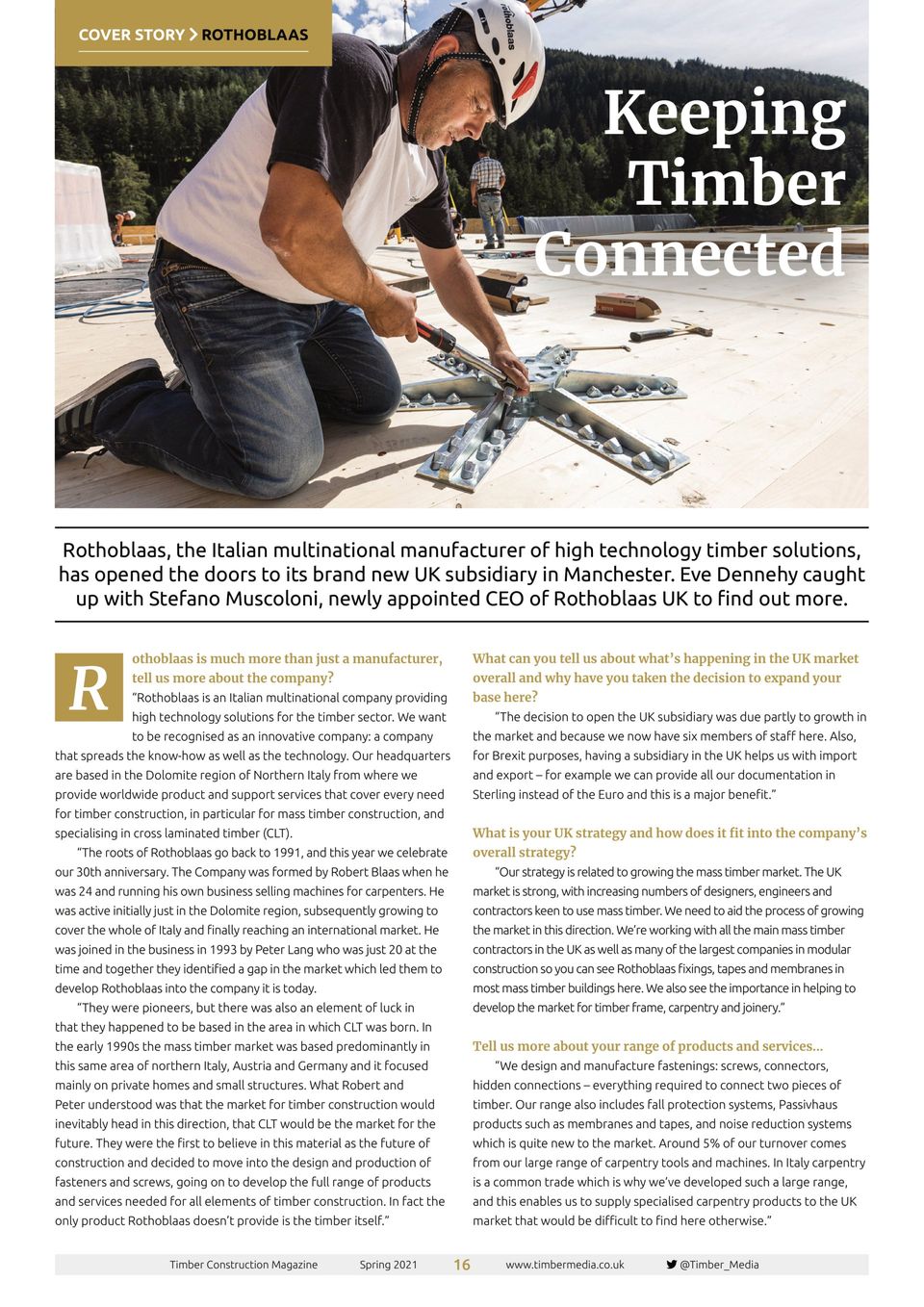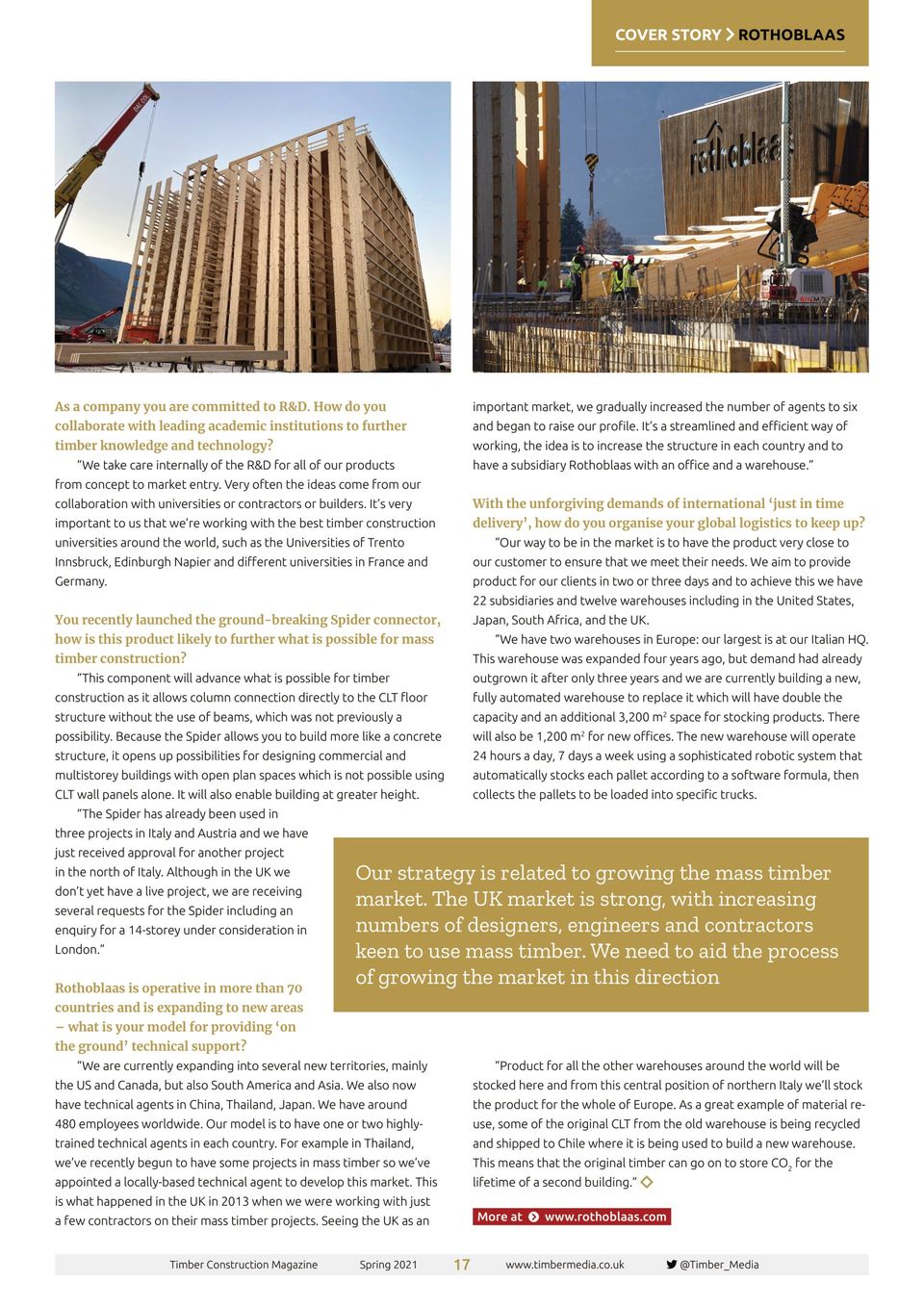Keeping Timber Connected
Mark Wilson • 17 March 2021

Our web site has now been amended to add some elements of the Rothoblaas Holz Technic range. Whilst we have selected a limited range of fixings, tapes and membranes, we are always happy to discuss your wider needs. These high quality products have been developed to be used in conjunction with a variety of timber engineered solutions including: glue laminated timber, cross laminated timber [CLT] and I Beam construction. As well as providing the fixings to join elements we can also supply an air tightness tape and high performance vapour check layers [VCL] and breather membranes.

Grafton Boards Limited is delighted to announce that they have formed a strategic partnership with Rothoblaas an Italian manufacturer of high technology solutions for the timber construction industry. It is Grafton’s intention to initially distribute a select range of products from the manufacturer’s extensive product portfolio under Rothoblass’ retail brand of “Holz Technic,” [wood technology]. It is intended to concentrate on: a range of fixings for timber frame, cross laminated timber and fencing as well as connection plates; membranes and tapes for air tightness. Full technical support will be provided for all products and stocks will be held for short lead times. The range of fixings include: • Countersunk screws • Flange head screws • Double thread screws for installation of external wood fibre insulation • Self drilling screws / dowels • Thermo washers and insulation anchors The Connector plates include: • Concealed aluminium brackets for glulam, LVL and cross laminated timber • Angle brackets • Shear plates • CLT and Panel lifting plates The membranes and tapes include: • Reflective vapour control layers • Standard vapour control layers • Breather membranes • A range of tapes for ensuring great air tightness values. Product information will be uploaded to this e commerce site in the next few days.”

With multiple occupancy homes becoming the norm, one of the main sources of irritation to property owners or tenants is noise, whether that be from airborne sound or from impact sound. There are a number of solutions out there for new build but it is the retrofit market where easy to fix solutions are sought after. After all, the removal of carpets and underlays and replacement with wood or laminate seem like a great idea until the realities of everyday life occur. Retrofit soundproofing has been made easy with PhoneStar, a versatile, high performance and simple to use acoustic insulation product. It exceeds Building Regulations for the Resistance to the Passage of Sound in the UK and Ireland. This CE marked, eco-friendly, natural and breathable soundproofing board provides outstanding results for both airborne sound reduction (e.g. talking, music, television noise) and impact sound reduction (e.g. footstep and furniture noise) by application to walls, floors and ceilings. At only 15mm thick, PhoneStar is an ideal soundproofing solution for new builds, conversions, refurbishments and remedial projects and is easy to install. As an added benefit this high density material adds thermal mass to the structure assisting with summer heat gain. In effect it will absorb heat during the day and release it at night, as the room cools. The PhoneStar soundproofing board on its own has been certified to reduce Airborne Sound by 38 Decibels (dB) (Rw, Ctr = -5). When the acoustic insulation board is then added to a wall, floor or ceiling structure comprising of, for example: plasterboard, dynamic battens and between joist insulation, the overall Airborne Sound Insulation result of the complete structure will be much higher. PhoneStar also reduces Impact Sound by a very significant 22dB (ΔLw) when laid on the industry standard concrete test floor. The overall impact sound insulation result of the complete floor and ceiling structure can also be tested and this laboratory result in Decibels is denoted by Ln,w. PhoneStar is a dense product with a high mass, but it is also pliant due to its compacted but loose quartz sand filling. This is contained within an engineered, fluted cardboard carcass. These properties allow the product to absorb sound and resist its passage from surface to surface. PHONESTAR BENEFITS • 60dB Airborne and 53dB Impact Insulation for a simple Part-E timber floor structure • 38dB (Rw, -5Ctr) Airborne and 22dB (ΔLw) Impact sound insulation on its own • Impact insulation improves by a further 3dB when a hard floor surface is fitted on top • For new build, conversion, remedial and refurbishment projects • PhoneStar is natural, breathable, pollutant free and odourless • Only 15mm thick • Easy to cut and fit with simple butt joints with no special tools or expertise required • High speed of installation resulting in lower labour cost • Excellent thermal mass and recommended with underfloor heating systems • Feels like a solid floor underfoot rather than a spongy feel common with foam products • Internal non-load bearing walls can be built on top due to very high loading capacity • Heat storage capacity Samples are available for evaluation and this product is available from stock.
In the 90’s there was a building design feature that dogged timber frame construction, namely the control of interstitial condensation. In essence where water vapour is trapped within a timber frame, there is the risk of condensation forming within the heart of the structure and thus increasing the risk of fungal growth. The standard approach to tackle this was to add a breather paper to the outside of a timber frame, behind the rainscreen whether; brick, render or weatherboarding. On the inside a vapour control membrane would be added behind the plasterboard to prevent water ingress caused by the generation of moisture in the operations of daily life such as condensation from showers etc. To combat the risks and codify an agreed approach BS 5250:2011, Code of Practice for Control of Condensation in Buildings was developed and the rule of thumb was that, if the internal lining “breathed” at a rate five times worse than the external lining, any moisture would migrate via the path of least resistance to the ventilated cavity. The concept of “breathing wall,” was born. This has always been a bit of a misnomer as it has nothing to do with the passage of air or airtightness but rather the movement of water vapour. There was a belief by some that the use of breather paper on an OSB / plywood racking board was a flawed approach, due to the high vapour resistance of those board types. This led to the development of Panelvent a board which, due to its method of manufacture, was inherently vapour open but also able to match the category 1 racking requirements of OSB or plywood. The board was originally manufactured in Sweden and used a wet process medium board with lignin bonding. The board has gone through various iterations to the product we now know as Panelvent DWD . This EN622-5 fibreboard is available in standard sizes of 12mm x 1,198mm x 2,398mm and is for use in service class 1 and 2 applications. It has a vapour open structure whilst retaining category 1 racking strength to BS5268. Whilst the key drivers in the current construction climate are thermal performance and airtightness, why not use an external sheathing board that can act as belt and braces should moisture get into the timber frame. By simply allowing a ventilated cavity and using a vapour check on the inside you can rely on panelvent DWD to naturally migrate any water vapour safely to the outside, without harming the frame. Panelvent DWD is favoured by specifiers using hygroscopic insulations such a cellulose fibre or woodfibre whether in batt form or blown in on site. It is also an E1 low formaldehyde board. It has been used widely on self builds, schools and public buildings. Contact us if you would like more information.

At the recent 2020 World Economic Forum in Davos, the concerns about Climate Change were front and centre. These concerns are all too obvious if one considers the recent devastating fires in Australia. Practical steps are being suggested to mitigate the effects and key to these is a programme of forestry replanting. So, what is the simple science behind this? We are all taught at school that, via a process of photosynthesis trees absorb CO2 and release the O2 we all need to thrive. Effectively, for every 1m3 of tree growth, a tree will hold / sequester 0.9 tonnes of CO2 and release 0.7 tonnes of O2. That Co2 is then locked in the harvested wood throughout its lifetime and during its use as a building material. If one were then to use insulation materials manufactured from wood fibres in every dwelling, we will gain improved thermal performance, reducing the need for increased winter heating and summer cooling. In addition, the sequestered Co2 remains in the structure. If you are thinking of building, why not use products like engineered timber joists and glulam rather than steel; or woodfibre insulation rather than PIR insulation? You will save CO2 in the manufacturing process and lock CO2 into the structure during its service life. The question is are we in Europe cutting down too many trees already? Well, in the last 25 years the EU Forest and other wooded land have increased by 9%. 43% of total European land area is now tree covered. The drive now is to increase Biodiversity by allowing natural re growth and increased broad leaf varieties of trees. If the new Government fulfils its replanting promises, we really may return to a Green and Pleasant Land.

The appg Timber Industries has published a report dealing with the current Housing Crisis in the UK. The report considers the advantage of using Timber Frame and with that, natural wood based materials, to tackle the shortage of UK housing. In the representation above, one can see three key advantages, should timber frame be adopted, to construct 270.000 homes per annum. These are: 300,000 tonnes of carbon sequestration; quicker builder times and 90% waste reduction. In these times of climate change and commitments to Zero carbon emissions, what better way to achieve a sustainable future, by choosing natural building materials for your project?



